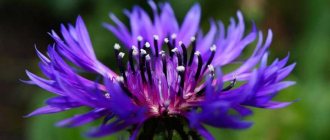The choice of planting location is determined by the characteristics of the variety: for example, miniature bushes can grow in the foreground of a flower garden or even in containers; tall people need space, and perhaps support. It should be remembered that roses generally do not like dense plantings - with poor air circulation, the risk of disease increases.
When choosing companions for the “ostok”, you need to pay attention to the harmony of their combination in color and texture. Lush English roses look spectacular against the backdrop of evergreen conifers. Gypsophila paniculata will add tenderness and airiness to the flower garden composition, and romantic natures will undoubtedly appreciate the classic combinations of roses with elegant lavender, fragile bells, and a modest mantle. Ornamental grasses - molinia, Chinese miscanthus, feather grass, gray fescue and others - can add originality and a modern touch to the composition.
The following are also considered successful partners for English roses:
- delphiniums;
- digitalis;
- Speedwell;
- garden geraniums;
- oregano;
- sage;
- tall species of alliums.
You should be careful with aggressive plants (for example, catnip): if you decide to include such flowers in the “retinue” of your roses, be sure to limit their growth.
Selection and description of English roses
The culture was bred by English farmer David Austin. In the 50s of the 20th century, while in France, he saw ancient roses. David's dream was to improve them. As a result of breeding work, he received a group of tall roses with large, fragrant buds. A distinctive feature of the ostina is the shape of the flower. Each variety has a unique floral aroma. D. Austin roses have the following characteristic features:
- bush height – from 1 to 3 meters;
- flowering - long, repeated;
- bud shape – cup-shaped, rosette, pompom;
- flowers are collected in inflorescences;
- The buds are large and fragrant.
English roses have good immunity and are rarely susceptible to disease or pest attacks.
Note! Austinkas have a strong aroma, most pronounced in the morning and evening. The most fragrant English rose is Jude The Obscure.
Features of "ostok"
Due to the wide variety of forms, it is difficult to give a general description of the roses bred by the famous family rose nursery David Austin Roses Limited. It should be noted that most “ostokos” are distinguished by abundant repeated flowering, endurance and high immunity. The smell deserves special attention - many “English women” have a unique, refined, strong aroma.
As a rule, shrubs do not require complex care and grow well in temperate climates. There are varieties with simple (according to some data up to 40%), semi-double and double flowers of different sizes and shapes - mainly nostalgic, cupped (rosette-shaped). The color scheme of the petals has a wide range.
A distinctive feature of English ramblers, including The Albrighton Rambler (Ausmobile - Austin, 2013), is repeated flowering throughout the season.
In the accepted international classification, “English Roses” are included in the “Modern Shrub Roses” garden group. The modern assortment of “Austin” collections includes more than 200 items and is impressive in its variety of species. These are not only bush forms (scrubs), but also climbing plants, which are climbing plants (Climbing) - bud mutations (sports) of bush varieties, as well as varieties belonging to the groups: Ramblers (R.) and Climbing large-flowered (Plt. Kr.) or Climbers (climbers) / Large-Flowered Climber (LCL). Almost all English ramblers, in contrast to the “classic” representatives of this “creeping” group that bloom once on the shoots of previous years, have repeating, that is, multiple flowering.
Among the English scrubs, which form lush, spreading, profusely flowering bushes, the following are widespread: “Graham Thomas”, “Abraham Derby”, “Crown Princess Margaret”, “Golden Celebration”, “William Shakespeare”, “Lady of Shalott”, “ Princess Alexandra of Kent", "Queen of Sweden", "Lady Emma Hamilton". Detailed information about them can be found in the articles published on our website.
David Austin roses (pictured) are grown as scrubs or climbers, used in single and group plantings when decorating various types of flower beds and vertical gardening
The most beautiful varieties and varieties
Experts have bred many varieties of English roses. Selection work was continued by the son and grandson of David Austin. The best varieties of roses are as follows.
James L. Austin
Austin, bred in 2022, is named after the breeder’s son. The bushes grow vertically. The shoots are covered with a large number of large purple-pink flowers. A fruity aroma emanates from the bushes. The rose is resistant to most diseases.
Vanessa Bell
The variety is named after the famous British artist. The height of the bushes is about 120 centimeters. The rose spreads up to 75 centimeters in width. 3-5 buds are formed on the stem. They are painted a soft lemon color. The buds bloom all season almost without interruption. The aroma of lemon, honey, and green tea emanates from the bushes.
The Mayflower
Rose was bred in 2001. The height and width of the bushes is about 1 meter. It blooms almost non-stop from May until the first frost. The buds are colored pink. In spring the foliage is light green, becoming dark and matte in autumn. The flowers smell like rose oil.
See also
When is it better and how to properly transplant roses to another place?
Read
Golden Celebration
Shoots of Golden Celebration reach a height of 1.5 meters. Under the weight of the flowers they droop slightly towards the ground. The color of the buds varies from pale yellow to peach. Flowers open in early summer. Then, after a short break, repeated waves of flowering occur.
Lady of Shalott
This is one of the hardy, frost-resistant varieties. The bushes reach a height of 120 centimeters. The shoots droop slightly. The flowers are cup-shaped, densely double. The center of the bud is salmon pink. The edges of the petals are golden-orange. Ostinka exudes the aroma of apples and cloves.
Dame Judi Dench
The vigorously growing shoots of the crop reach a height of 1.2 meters. The width of the bushes is 90 centimeters. The buds are apricot-colored. They exude a cucumber aroma. Flowers form throughout the season. The plant's resistance to disease is excellent.
William Shakespeare
Considered the best English red rose. The bush is erect. The shoots are covered with purple flowers. At the opening stage, the buds are cup-shaped. When opened they become flat. In 2000, an improved variety, William Shakespeare 2000, was developed. It is more resistant to various diseases.
Graham Thomas
The shoots are long, arched. They reach a height of 1.5-3 meters. The buds are cup-shaped, terry. Number of petals – up to 75 pieces. Color varies from peach to orange. If exposed to bright sunlight, the petals may fade. The buds grow profusely in early summer. After the first wave, moderate flowering occurs until frost.
Abraham Derby
The height of the bushes is 100-150 centimeters. The higher the shoots, the more they droop under the weight of the inflorescences. The aroma is fruity, with a strawberry note. The buds are cup-shaped, copper-apricot color. Under the influence of the hot rays of the sun they turn soft pink. Flowers are arranged singly or in racemes of up to 3 pieces.
Benjamin Britten
The variety is named after the English composer and conductor. Grows up to 110 centimeters. The flowers are densely double, crimson in color. The bushes give off a fruity aroma with notes of pears. English rose can be used as a container plant.
The planting is bouquet, noticeable from a distance
Everything is individual. On sand and close to the surface level of groundwater, roses are almost never very large.
The spruce tree is selfish, does not like competition and will aggressively suppress everything that grows nearby. It's better not to waste effort and time on it.
For triangles from the same variety - again, very individually, of the 11 triangles that I planted, they were abandoned for today. If you wait and be patient, the situation could well get better, but I didn’t want to wait and there was a catastrophic lack of space. There is not a single photograph of flowering groups of these roses, they look funny, Melja is blooming, there is discord, I understand, and if I choose some variety, I will definitely inquire about how best to plant this variety, having a certain area for planting, but the very idea of large “homogeneous” I like arrays.
Osenka, blue stones - how is it? As of today, I only have one of the groups left - Crown Princess Margaretha.
There are two seedlings next to each other and a floribunda Marie Antoinette is planted on the side. But Jude the Obscure, although two years and one bush younger, has completely caught up in size with his younger sisters. Moreover, they were sent with detailed, but as I have found out over the past two months, not entirely correct but not so radical instructions, but the power of arrogance is great.
Now let's be more careful. And your bush, Olga, is very pretty. I hope to see some similarity in myself soon. Lenok: Anyway, your dad is great!!! The more we allow them, roses, the better they grow, this is definitely Olga, yours is more beautiful than mine, definitely.
I’ll tell you a secret, I’ve already transplanted mine three times. The last time I replanted everything in buds, I didn’t cut anything, there was no time. It bloomed and is still alive.
Here's an unsinkable aircraft carrier: But my flowers are not as double as yours, and not as large, and if you remember how long I looked for her, how many roses I bought under her name, even this one was not Schneewithchen, but under the name While love or something like that. Only when it blossomed did I realize who it was.
Lar, or maybe precisely because they know that I will never transplant them under any circumstances - they try on the spot? And about Schnee Thanks again! How did I live without a forum before? Lenok: It is in all respects - absolutely problem-free, it was bred in the year, I have s In all: It does not give in to diseases, I’ll make a reservation - all my roses never get sick with anything, aphids try, and there are those who don’t try, but one watering with Aktara - and it’s clean, it grows vigorously, it winters easily - I cover the whole crowd with lutrasil in two layers.
The color is pale pink, does not fade, the bud is dense, of an old English shape, it blooms almost continuously, until the snow. The bush is dense.
About the smell Visit Where to buy Look on the Internet Read. Forum archive Competitions Chat conferences Lectures. Hello, new visitor! Now Where to buy. Look on the Internet. Forum archive. Do you know how to graft woody plants? Bouquet planting. Do you have any experience? And I really like this rose, it’s an extraordinary worker - it blooms from morning to evening and all summer until late autumn O: Lak. And the presence of the vaccine was obvious even to me, an inexperienced person: TOK.
Oh, I just imagined such plantings - once every year - a huge pink bush: Lara. As soon as I inherit Abramovich, I will begin to set controls for experiments in rose growing: but for now, I’m afraid to get smart, pick apart what looks good, ttt TOK. Sorry, and for some reason I called her that, even I felt ashamed: Lara.
It is so beautiful! Have the “Polyanthus Roses” bloomed? Rose is a favorite. Rose on the balcony. Austins are successful combinations. Vaccination at a rose gardener.
Yellow-orange varieties h-g. Variety "Acropolis". A flowerbed of roses in red and white colors. Large rose bushes. Papa Meilland.
How to plant on the site
Plant the crop in a well-lit area. In cold regions, the procedure is carried out in the spring. Roses have time to adapt before the onset of frost. In hot areas, ostinki can be planted in September. Autumn planting has the advantage that the gardener can see the flowers growing on the purchased bush.
The distance between the bushes depends on the variety of roses. The holes are dug 50x50 centimeters in size. They are filled with nutrient substrate. A day before planting, the seedling is placed in a root-forming mixture.
Planting a plant
Ostinka was first brought to our region relatively recently, just over 10 years ago. And only the most cold-resistant varieties were awarded this honor.
You need to be very responsible when purchasing a seedling, since in our market it is very difficult to find a high-quality specimen that matches the variety. It is best to use the services of specialized nurseries that deliver to our country. If you are dealing with amateur gardeners, you need to meticulously examine the item you are purchasing and make sure that the person is conscientious, since under the guise of an expensive English rose you can buy a cheap tea rose or even a rose hip.
It is best to plant roses in September or October, depending on the region, well before frost to allow the plant to establish itself. If you wish, you can plant the bush in the spring.
This plant has no special requirements for the soil, the main thing is that it allows air to pass through and is away from destructive groundwater. It is best to prepare a mixture of soil and sand in advance, adding humus or peat if desired.
Before planting, the seedling should be kept in water for a while, and then the roots should be treated with a clay solution of water, clay and manure in a ratio of 10 parts of the first and 3 parts of the second and third components.
Pour plenty of water into the dug hole and allow it to be completely absorbed. Then the English roses are lowered into the hole so that the rootstock sinks to a depth of about 10 cm. The roots are thoroughly straightened and covered with substrate, compacting as it is added, the plant is watered and a small hill is created around the stems. The final step will be to trim the stems to 6-8 buds, all leaves must be removed.
Caring for English roses
Caring for the crop consists of timely watering, periodic fertilizing, and loosening the soil. Faded buds and part of the stem are cut off. To prevent the appearance of diseases and pests, bushes are treated with special preparations.
Watering mode
The land around the bushes is irrigated abundantly, but not often. The top layer of soil should have time to dry out. If there is excess moisture, the leaves may become susceptible to fungal diseases. Depending on the size, a plant requires 5-15 liters of water.
See also
Description and characteristics of Gloria Day roses, planting and care rules
Read
Fertilizing bushes
They begin to feed English roses the next year after planting. Nitrogen applied in early spring promotes rapid growth of bushes. During the budding period, a phosphorus-potassium mixture is used. After flowering, potassium is used.
Loosening the soil
After watering, the soil around English roses is loosened. The procedure helps air and moisture penetrate to the root system. When loosening, weeds growing around the bushes are removed. They interfere with plant development and can be carriers of pests and pathogenic microorganisms.
Trimming and shaping
Pruning roses in spring. If the gardener wants to grow small bushes, he must remove the shoots by half. If tall plants are needed, cutting is carried out to a third of the length of the stems. Climbing varieties of ostina require pruning of ⅕ of the branches.
Important! Work on the formation of bushes is carried out with a sharp, disinfected instrument.
Preventive and therapeutic treatments
To prevent the appearance of diseases and pests, the bushes are treated with special preparations. Fungicides are used for fungal diseases. Insecticides are used to prevent and rid roses of insects. Preventing the occurrence of misfortunes is facilitated by removing plant debris from the tree trunks of plants.
Preparing for winter
In warm areas, it is enough to sprinkle the ground around the plants with a layer of mulch in late autumn. In cold regions, a frame is installed above the bushes, which is covered with non-woven material. The procedure is carried out after the temperature has remained at -5 °C for several days. If you carry out moisture-recharging irrigation in mid-autumn, the saplings will withstand frosts better.
Flower symbol of Georgia. Flag of Georgia
The flag is a symbol without which it is impossible to imagine the state. Georgia also has its own state symbol. The modern flag of Georgia is a white canvas with a large bright red cross on it. Using this cross, the canvas is divided into equal rectangles. They also contain a red cross, which is a smaller copy of the large cross.
The origin and significance of the Georgian flag
The history of the Georgian flag, which depicts 5 crosses, goes far into the past. A similar model first appeared in the middle of the 13th century, during the reign of George V, and before that time there was only a large cross on the flag of the Georgian kingdom.
The red cross on the flag of the Georgian state is widely known throughout the world. Some call it Georgievsky and consider it a real symbol of the Georgian kingdom. Smaller copies of the cross, located in four rectangles, are called Bolnisi.
The cross has long been considered an unchanging Christian symbol and was revered, so it is not surprising that previously it could be seen on the symbols of many states. On the Georgian flag, a large cross represents Jesus Christ, revered by all, and 4 small crosses represent his closest holy evangelists.
White color is considered to represent great wisdom and immaculate, unsullied purity. It also identifies sincere innocence. Bright red is unconquered courage, pure and sincere love, wise justice and incredible courage.
History of the Georgian Banner
The flag with five crosses has almost always been considered an unchanging symbol of Georgia. In some years it changed to a tricolor flag, which included red as well as white and black. Similar changes to state symbols occurred in some periods before 2004.
The colors on this flag had their own special designation. Dark red was considered a sign of great hope for the advent of favorable times in the future and symbolized the worldwide glory of the past. White symbolized confidence and hope, and black was a constant symbol of permanent Russian rule.
Officially, the white and red flag, on which there are five crosses, was approved in 2004. This happened after the people's revolution that took place in 2003. The persistent, rebellious and freedom-loving people of Georgia considered this flag to be a symbol of real victory, which would help unite the divided state. He was supposed to help restore its former glory and lead to the flourishing of the Georgian state. As a result, the struggle against the Shevardnadze regime ended in victory and the flag with five crosses was officially recognized as a symbol of Georgia.
Reproduction
English roses are easily propagated by cuttings or layering.
By cuttings
To propagate the crop using this method, cuttings 20 centimeters long are cut. The lower leaves are cut off, the upper leaves are left. The shoots are planted in the ground at a distance of 15 centimeters and covered with a jar. In late autumn, the bed is covered with agrofibre. The bushes are planted in a permanent place after a year.
By layering
Climbing roses are propagated using this method. An incision is made on the shoots and placed in pre-dug grooves. They are secured with staples, watered, and covered with earth. Layers need to be looked after: irrigate and loosen the soil, remove weeds. The transplant is carried out after a year.
Trimming
Caring for an English rose also includes pruning. Without this procedure, it is unlikely to look truly beautiful; the bush should be decorated almost from the moment of planting. When sprouts appear, the soil is slightly raked away from the plant, loosened and sprinkled with straw. After the shoots become stronger, they are thinned out, leaving 3 or 4. When they grow, you should start pruning. It’s worth remembering the rule: if the goal is to get large flowers, then you need to halve the size. If you cut off the third part, this will contribute to the appearance of a large number of buds. The climbing look needs to be shortened by only a fifth.
If the English rose is mature, then it must be pruned no later than April, otherwise flowering will be late. All damaged, diseased, small shoots should be removed without delay. You need to make sure that there are no wilted flowers on the bush - this slows down the appearance of buds. Old, woody shoots that are more than 5 years old are also removed.
The pruning tool must be sharp to avoid damaging the bark. It is recommended to treat the cut area with a disinfectant solution.
Growing an English rose requires attention and time. But caring for her will be a pleasure, because the result can exceed expectations. It is not for nothing that the plant, bred not so long ago, is loved by gardeners.
The main components of care are watering, fertilizing and pruning. All procedures must be carried out regularly, only then will it be possible to ensure spectacular flowering.
Preparing for winter
English roses, if unprotected, do not tolerate Russian winters, so for successful wintering they require thorough preparation and protection. The preparation is proper care during the summer and regular feeding. Protection from frost should be taken care of separately.
With the onset of autumn, it is important not to pick flowers from the bushes so that they can bloom and fall off on their own. This will contribute to more complete ripening of the shoots. With the onset of cold weather, the leaves that have not flown off are removed, and the immature shoots are cut out completely. Then you can start covering.
Important! Plantings can be covered only after a steady drop in temperature to negative readings (but not below -10 degrees).











